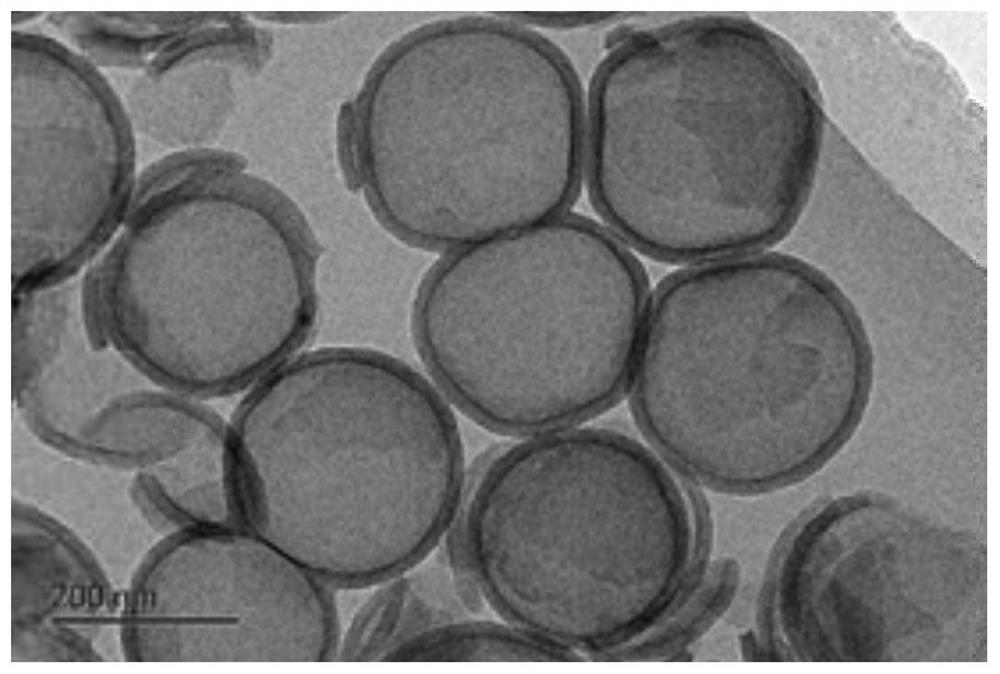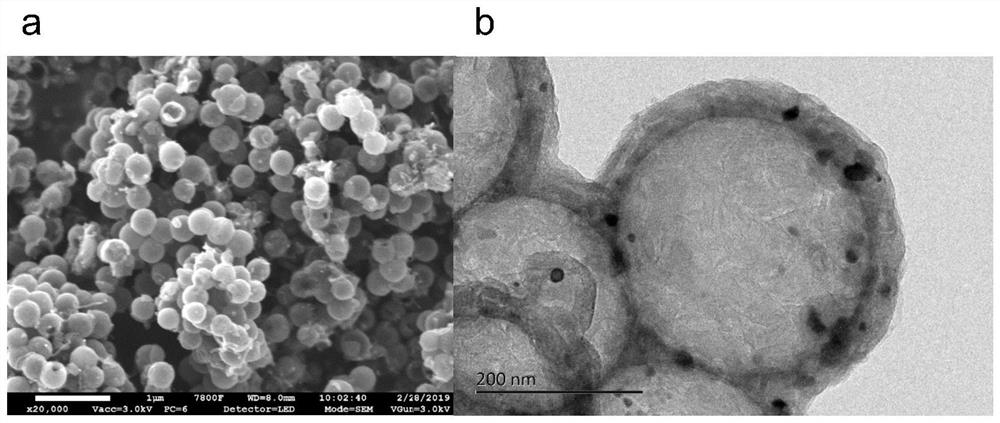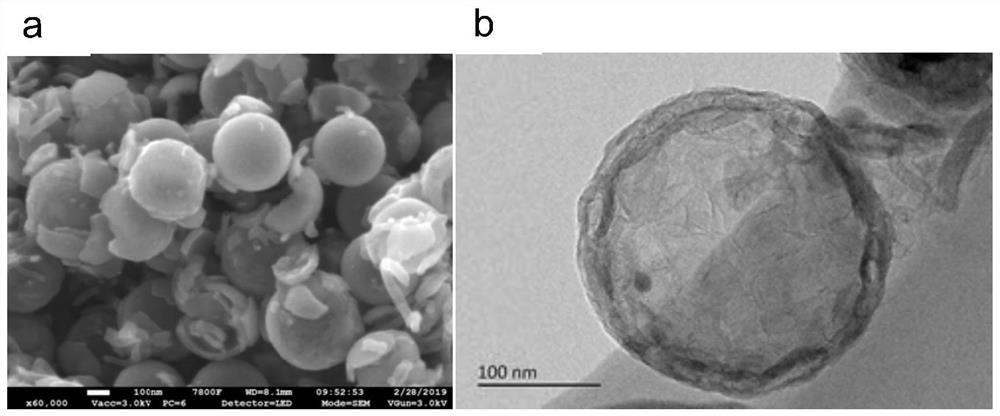Preparation and application of carbon dioxide electrochemical reduction catalyst
A carbon dioxide, carbon-based catalyst technology, applied in catalyst activation/preparation, physical/chemical process catalysts, chemical instruments and methods, etc., can solve the problems of metal atom agglomeration, catalyst performance degradation, etc. Effect
- Summary
- Abstract
- Description
- Claims
- Application Information
AI Technical Summary
Problems solved by technology
Method used
Image
Examples
Embodiment 1
[0036] 1) Add solution A: 2.55ml ethyl orthosilicate into 45ml ethanol and stir; add solution B: 6ml 25% ammonia water and 9ml water into 30ml ethanol and stir. Add solution A into solution B and stir for 1 hour; pour solution B into the reaction kettle for hydrothermal treatment at 100°C for 24 hours, rinse the product after hydroheating with distilled water for more than three times, then dry it at 70°C for 8 hours, take the dried sample for 600°C Argon high-temperature calcination for 3h, heating rate 2 ℃ / min. Add 3g of the calcined product to 40ml (20%) hydrofluoric acid solution and etch for 24h, and finally obtain a hollow carbon sphere support rich in microporous structure.
[0037] 2) Add 0.1g of hollow carbon sphere carrier, 50mg of nickel chloride and 0.6g of melamine into 20ml of ethanol solution, stir at 25°C for 12h, evaporate to dryness in a water bath at 80°C, and then dry for 12h;
[0038] 3) The dried sample was calcined in argon at 1000°C for 1h at a heati...
Embodiment 2
[0044] 1) Add solution A: 2.55ml ethyl orthosilicate into 45ml ethanol and stir; add solution B: 6ml 25% ammonia water and 9ml water into 30ml ethanol and stir. Add solution A into solution B and stir for 1 hour; pour solution B into the reaction kettle for hydrothermal treatment at 100°C for 24 hours, rinse the product after hydroheating with distilled water for more than three times, then dry it at 70°C for 8 hours, take the dried sample for 600°C Argon high-temperature calcination for 3h, heating rate 2 ℃ / min. Add 3g of the calcined product to 40ml (20%) hydrofluoric acid solution and etch for 24h, and finally obtain a hollow carbon sphere support rich in microporous structure.
[0045] 2) Add 0.1g of hollow carbon sphere carrier, 50mg of nickel chloride and 0.6g of melamine into 20ml of ethanol solution, stir at 25°C for 12h, evaporate to dryness in a water bath at 80°C, and then dry for 12h;
[0046] 3) The dried sample was calcined in argon at 900°C for 1h, the heatin...
Embodiment 3
[0049] 1) Add solution A: 2.55ml ethyl orthosilicate into 45ml ethanol and stir; add solution B: 6ml 25% ammonia water and 9ml water into 30ml ethanol and stir. Add solution A into solution B and stir for 1 hour; pour solution B into the reaction kettle for hydrothermal treatment at 100°C for 24 hours, rinse the product after hydroheating with distilled water for more than three times, then dry it at 70°C for 8 hours, take the dried sample for 600°C Argon high-temperature calcination for 3h, heating rate 2 ℃ / min. Add 3g of the calcined product to 40ml (20%) hydrofluoric acid solution and etch for 24h, and finally obtain a hollow carbon sphere support rich in microporous structure.
[0050] 2) Add 0.1g of hollow carbon sphere carrier, 25mg of nickel chloride and 0.6g of melamine into 20ml of ethanol solution, stir at 25°C for 12h, evaporate to dryness in a water bath at 80°C, and then dry for 12h;
[0051] 3) The dried sample was calcined in argon at 1000°C for 1h at a heati...
PUM
| Property | Measurement | Unit |
|---|---|---|
| concentration | aaaaa | aaaaa |
| diameter | aaaaa | aaaaa |
Abstract
Description
Claims
Application Information
 Login to View More
Login to View More - R&D
- Intellectual Property
- Life Sciences
- Materials
- Tech Scout
- Unparalleled Data Quality
- Higher Quality Content
- 60% Fewer Hallucinations
Browse by: Latest US Patents, China's latest patents, Technical Efficacy Thesaurus, Application Domain, Technology Topic, Popular Technical Reports.
© 2025 PatSnap. All rights reserved.Legal|Privacy policy|Modern Slavery Act Transparency Statement|Sitemap|About US| Contact US: help@patsnap.com



